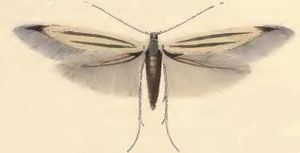Coleophora chalcogrammella
| Coleophora chalcogrammella | |
|---|---|

| |
| Scientific classification | |
| Kingdom: | Animalia |
| Phylum: | Arthropoda |
| Class: | Insecta |
| Order: | Lepidoptera |
| Family: | Coleophoridae |
| Genus: | Coleophora |
| Species: | C. chalcogrammella
|
| Binomial name | |
| Coleophora chalcogrammella | |
Coleophora chalcogrammella is a moth of the family Coleophoridae. It was first described by Philipp Christoph Zeller in 1839 and is found in Europe.
Description
The wingspan is 8–10 millimetres (0.31–0.39 in)
The larvae feed on thyme-leaf sandwort (Arenaria serpyllifolia), field mouse-ear, (Cerastium arvense), three-nerved sandwort (Moehringia trinervia), lesser stitchwort (Stellaria graminea) and greater stitchwort (Stellaria holostea). In autumn, the larvae make a short corridor, which widens into a small blotch, out of which the first case is cut. After hibernation, the final case is made. It is a brown, three-valved, tubular silken case of about 6 millimetres (0.24 in) long. The mouth angle is about 30°.[2] Full-grown cases can be found in May.
Pupa: The pupae of moths have visible head appendages, wings and legs which lie in sheaths.[3]
Distribution
It is found from Sweden and northern Russia to the Pyrenees and the Alps and from Great Britain to Romania.
References
- ^ "Coleophora chalcogrammella Zeller, 1839". Fauna Europaea. Retrieved 11 December 2019.
- ^ "Coleophora chalcogrammella". Plant Parasites of Europe. Retrieved 10 August 2020.
- ^ "Coleophora chalcogrammella Zeller, 1839". UKflymines. Retrieved 11 December 2019.
External links
Error: "Q5143360" is not a valid Wikidata entity ID.
- Articles with short description
- Articles with 'species' microformats
- Commons category link is the pagename
- Taxonbars desynced from Wikidata
- Taxonbar pages requiring a Wikidata item
- Taxonbars with invalid from parameters
- Taxonbars without secondary Wikidata taxon IDs
- Coleophora
- Moths described in 1839
- Moths of Europe
- Taxa named by Philipp Christoph Zeller
- All stub articles
- Coleophoridae stubs